
Panettone is an Italian type of sweet bread, and fruitcake, originally from Milan, usually prepared and enjoyed for Christmas and New Year in Western, Southern, and Southeastern Europe as well as in South America, Eritrea, Australia, the United States and Canada.
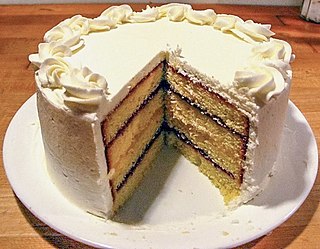
Cake is a flour confection made from flour, sugar, and other ingredients and is usually baked. In their oldest forms, cakes were modifications of bread, but cakes now cover a wide range of preparations that can be simple or elaborate and which share features with desserts such as pastries, meringues, custards, and pies.

Fruitcake is a cake made with candied or dried fruit, nuts, and spices, and optionally soaked in spirits. In the United Kingdom, certain rich versions may be iced and decorated.

Russian cuisine is a collection of the different dishes and cooking traditions of the Russian people as well as a list of culinary products popular in Russia, with most names being known since pre-Soviet times, coming from all kinds of social circles.
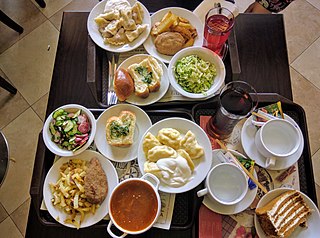
Ukrainian cuisine is the collection of the various cooking traditions of the people of Ukraine, one of the largest and most populous European countries. It is heavily influenced by the rich dark soil (chornozem) from which its ingredients come, and often involves many components. Traditional Ukrainian dishes often experience a complex heating process – "at first they are fried or boiled, and then stewed or baked. This is the most distinctive feature of Ukrainian cuisine".

Challah is a special bread of Ashkenazi Jewish origin, usually braided and typically eaten on ceremonial occasions such as Shabbat and major Jewish holidays. Ritually acceptable challah is made of dough from which a small portion has been set aside as an offering. Challah may also refer to the dough offering. The word is biblical in origin, though originally referred only to the dough offering. Similar braided breads such as kalach and vánočka are found across Central and Eastern Europe.

In many European countries, there are various traditions surrounding the use of bread during the Easter holidays. Traditionally the practice of eating Easter bread or sweetened "communion" bread traces its origin back to Byzantium and the Orthodox Christian church. The recipe for sweetened or "honey-leavened" bread may date back as far as the Homeric Greek period based on anecdotal evidence from classical texts that mention this type of special food. It is also widely known that sweetened bread desserts similar to panettone were a Roman favorite.

Kolach or kalach is a traditional bread found in Central and Eastern European cuisines, commonly served during various ritual meals. The name originates from the Old Slavonic word kolo (коло) meaning "circle" or "wheel". Korovai is sometimes categorised as a type of kolach.

Tsoureki also known as Šurēk, choreg or "chorek", çörək (Azerbaijani), çyrek (Albanian), kozunak, cozonac (Romanian) or paskalya çöreği (Turkish) is a sweet holiday bread made with flour, milk, butter, eggs, and sugar and commonly seasoned with orange zest, mastic resin, or mahlab. Lampropsomo, a variation of tsoureki commonly called "Greek Easter bread," is made by Greek communities during Easter, not only in Greece, but also in other countries with Greek communities. It is also sometimes called Armenian Easter bread.
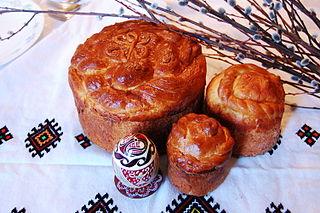
Paska is a sweet decorative bread native to Ukraine. It is a variation of Easter bread, a tradition particularly spread in countries with predominant Eastern Orthodox religious or cultural connections to the ancient Byzantine Empire. Paska breads are a traditional element in the Easter holidays of Ukraine, Armenia, Belarus, Romania, Russia, Georgia, Moldova and parts of Bulgaria, as well as Turkey, Iran and the Assyrian-Chaldean-Syriac diaspora. Due to its geographical closeness, it is also widespread in Slovakia. Meanwhile, it is also eaten in countries with immigrant populations in Eastern Europe such as the United States, Canada and the United Kingdom.
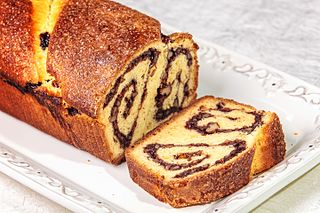
Cozonac or Kozunak is a sweet yeast dough that can be used to make different traditional holiday breads and cakes. Often mixed with raisins, it can be baked as a loaf or rolled out with fillings like poppy seed or walnuts. It is common throughout Southeastern Europe, Romania, Bulgaria and Serbia, North Macedonia, Greece, etc. Rich in eggs, milk and butter, it is usually prepared for Easter in Romania, Serbia, Bulgaria, and in Romania and Moldova it is also traditional for Good Friday. The name comes from the Bulgarian word for hair-коса/kosa, or Greek: κοσωνάκι, romanized: kosōnáki, a diminutive form of κοσώνα, kosṓna.

Paskha is a Slavic festive dish made in Eastern Orthodox countries which consists of food that is forbidden during the fast of Great Lent. It is made during Holy Week and then brought to Church on Great Saturday to be blessed after the Paschal Vigil. The name of the dish comes from Pascha, the Eastern Orthodox celebration of Easter. Besides Russia, Ukraine, etc. Pasha is also often served in Finland.
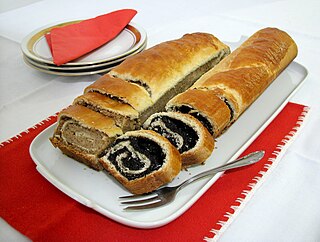
The poppy seed roll is a pastry consisting of a roll of sweet yeast bread with a dense, rich, bittersweet filling of poppy seed. An alternative filling is a paste of minced walnuts, or minced chestnuts.

Easter traditions are customs and practices that are followed in various cultures and communities around the world to celebrate Easter, which is the central feast in Christianity, commemorating the resurrection of Jesus. The Easter season is seen as a time of celebration and feasting, in contrast to the antecedent season of Lent, which is a time of penitence and fasting.
The holiday of Easter is associated with various Easter customs and foodways. Preparing, coloring, and decorating Easter eggs is one such popular tradition. Lamb is eaten in many countries, mirroring the Jewish Passover meal.
Easter cakes are cakes prepared and served during the Easter season. Sharing a cake with family for Easter is an Easter tradition in many denominations and countries.




















